Never-Lasting Records: U.S. Olympic Trials Keep Getting Faster (1988-2016)
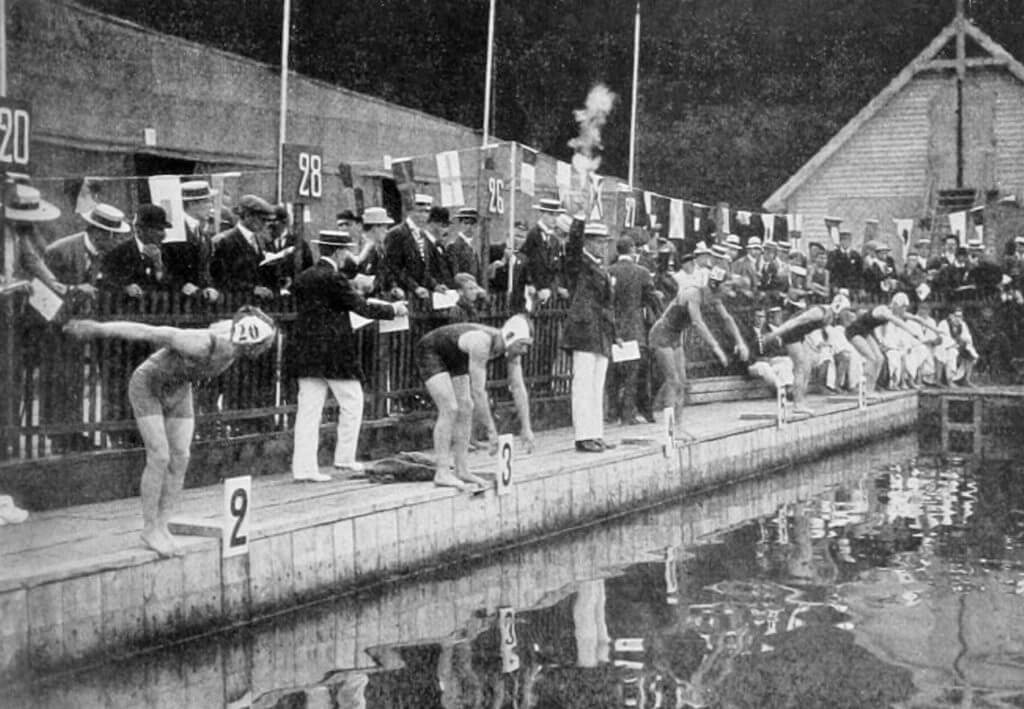
By Alan Karickhoff, Swimming World College Intern
While watching the U.S. Olympic Trials, there is a focus on the 50 meter splits and their proximity to the world record pace. This attention might distract many from the reality of U.S. swimming progression through the years. Often times, world records, American records, and U.S. Open records go untouched at Trials so it’s difficult to see if the sport is getting any faster.
It’s not until watching the Olympics through the T.V. that you’ll see many Olympians’ finger tips grazing the imaginary red line holding the world record pace. After an essentially complete white out of the world and Olympic records in the 2008 Olympic World Games, the 2012 Olympics were a bit of a disappointment.
Although the London Olympic Games weren’t another rewrite of the record books, in the first week seven new records were set. Many believed the records set in 2008 with the high-tech suits that are now banned would go untouched, so each new record was an extraordinary feat, as if the previous world records, in and of themselves, were not astonishing.
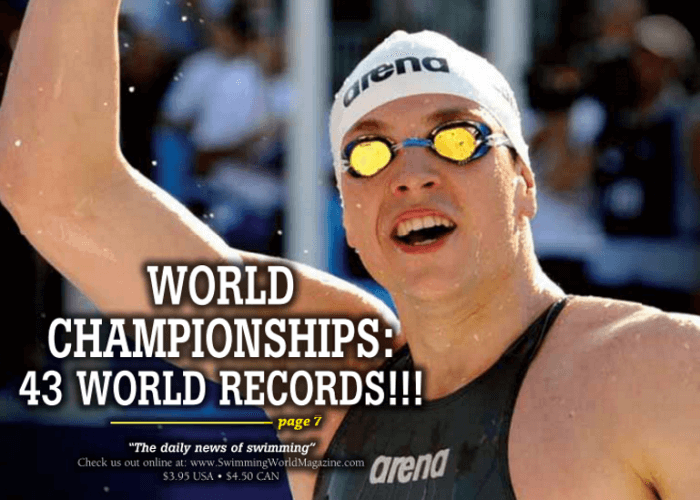
Photo Courtesy: Swimming World Magazine
Most long-course world records today stand from the 2009 World Championships, before the ban on high-tech swim suits. Some argued the records would stand for decades or more, and others labeled the new records with an asterisk. The suits sped up a natural progression towards records destined to be broken, though just a little faster than they would’ve been without the suits. Records have been falling throughout the history of swimming, and they aren’t showing any signs of sticking around for more than a couple of years. There are, however, some outliers, some men and women ahead of their time with records that stay fixed to the record boards for many years.
Some have argued it’s the technology of the sport that’s breaking records, not the athletes. Recently banned swim suits supported swimmers higher in the water, increasing buoyancy and decreasing drag. Swim caps decrease drag and make a swimmer more hydrodynamic. The invention of goggles gave swimmers greater vision and less chlorine burn, which allowed for them to spend more time training in the pool.
It could be the evolution of the sport that’s creating the time drops. Butterfly was recognized as a separate stroke from breaststroke in 1952 after swimmers recognized bringing their arms over the water was faster than under the water. The freestyle flip turn we now know today was popularized in 1965. More recently, the rule for the backstroke flip turn was changed in 1991 allowing swimmers to turn on their front before flipping. After a controversial 2004 Olympics in Athens, the breaststroke pullout was altered to allow a dolphin kick.
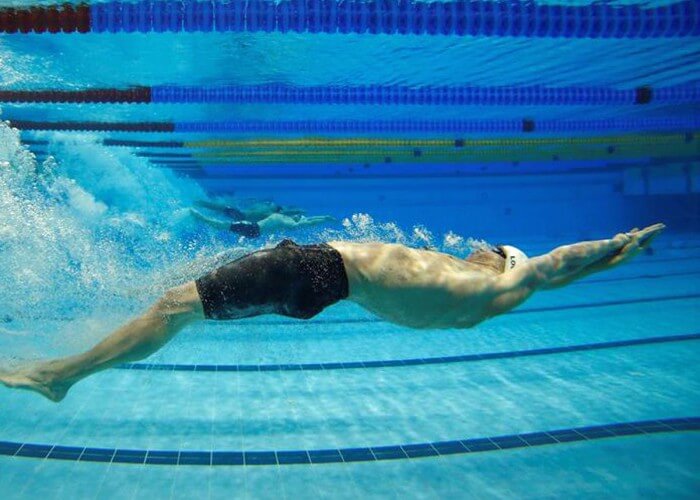
Photo Courtesy: FINA Doha 2014
Faster times are likely a result from a combination of these factors, and the evidence shows that banning a suit or limiting the distance underwater off each wall won’t keep records from tumbling from an unstable podium. More sophisticated suits, new turn techniques, better knowledge of nutrition, and more swimmers signing up every year shake the podium. With each year and more research, greater knowledge is available and more swimmers and coaches are using that knowledge.
U.S. Olympic Trials Progress (1988-2016)
Looking at the top eight swimmers in every event from the U.S. Olympic Trials from 1988 to 2016, there are clear improvements, not only from the top couple of swimmers but also the bottom few swimmers. All eight swimmers, as a group, show improvement from year to year. When only looking at the times from the two Olympic qualifiers, it’s tough to see the improvement because of spectacular, stand-out, races in previous Olympic Trials. All eight swimmers in the final heat need to be taken into consideration to see the improvements every four years. I expect an even broader inclusion of swimmers will show an even clearer line of progress.
Below are some graphs showing the improvement in the top eight swimmers at U.S. Olympic Trials from 1988 to 2016. They also clearly show the swimmers who swam races that were ahead of their time. Women are in red and men are in blue. 2008 appears to visually show a faster group across the events, but the following two Olympic Trials groups weren’t far from the year of the high-tech suits.
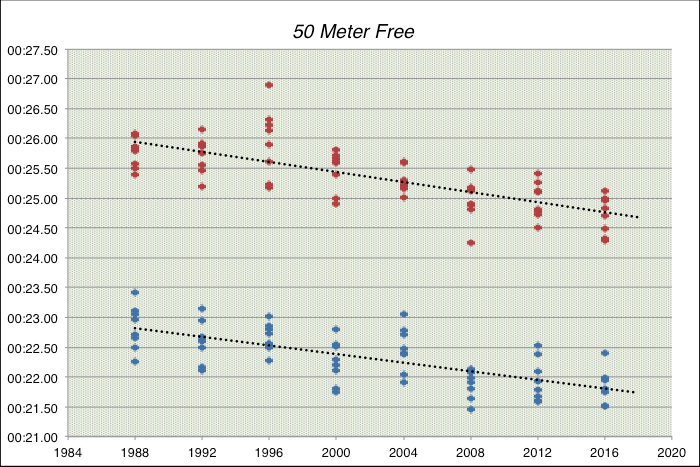
In 2008, Dara Torres touched in 24.25 in the 50 freestyle for an American record, more than half a second faster than anyone else in the finals heat.
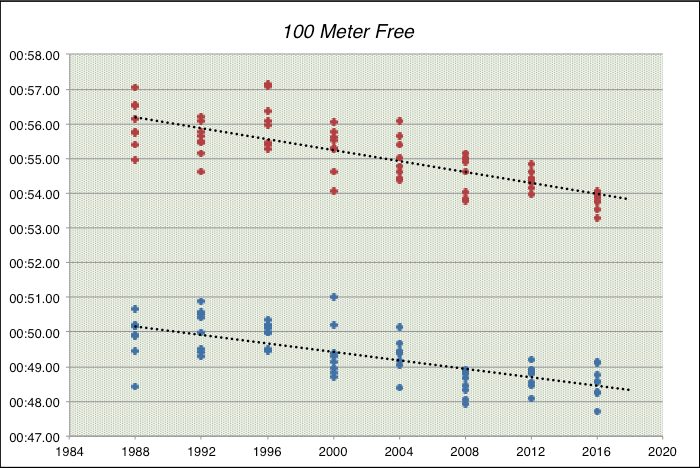
Above you can see Matt Biondi’s WR swim in 48.42, which went untouched in U.S. Olympic Trials finals history until Jason Lezek in 2004 swam a time of 48.41.
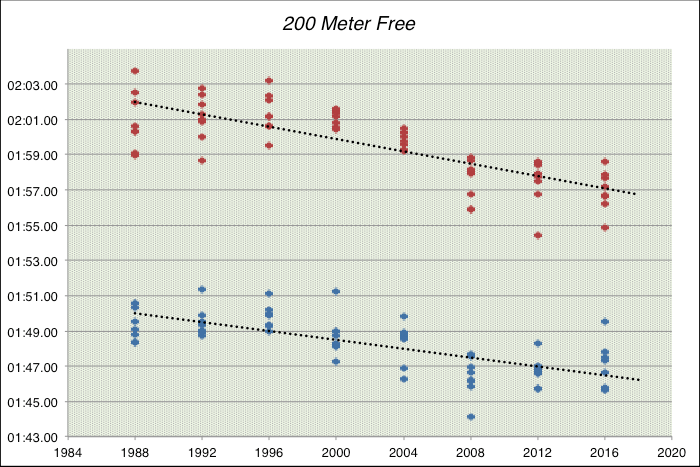
In 2012 and 2016, two women stood out from the rest, both surpassing any finalist in the 2008 Olympic Trials. Allison Schmitt finished in 1:54.40 in 2012 setting an American record and national record. Katie Ledecky touched first in 2016 in 1:54.88. Michael Phelps also took the 200 free to another level in the 2008 Olympic Trials with a time of 1:44.10.
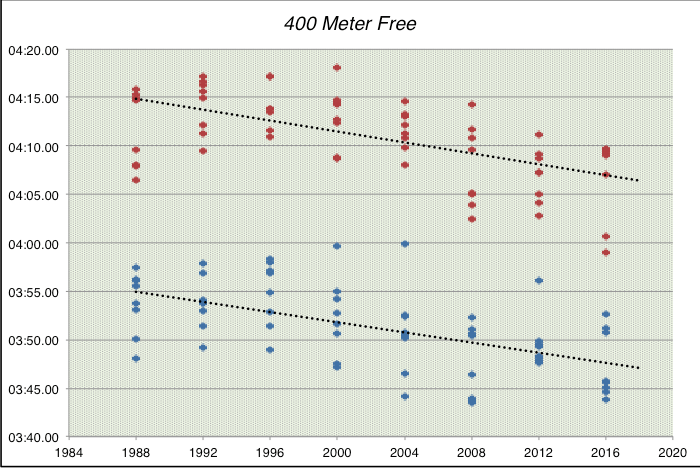
The 400 free is one of the events with the biggest variation among top competitors, but the most notable swims come from Katie Ledecky and Leah Smith. Ledecky surpasses previous male finalists with a time of 3:58.98 and Smith flirted with the four-minute mark with a time of 4:00.65. Klete Keller’s win in 2004 and Larsen Jensen’s win in 2008 with Peter Vanderkaay on his feet set new standards for the men with times of 3:44.19 and 3:43.53, respectively.
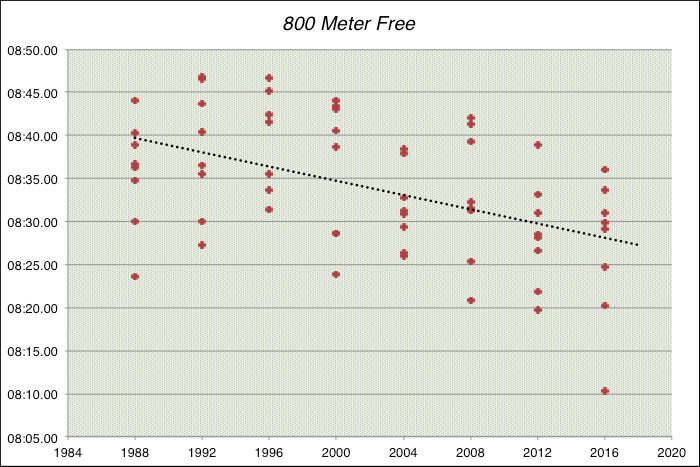
Once again, Katie Ledecky’s 8:10.32 in the 800 stands out from the rest. Before Ledecky, Janet Evans won the 1988 U.S. Olympic Trials with an 8:23.59, which was viewed as unsurpassable.
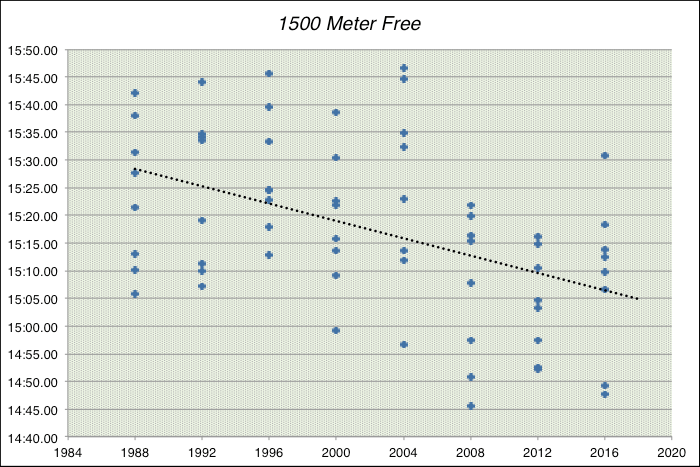
Vanderkaay’s 14:45.54 in the 1500 is still untouched from 2008, but Connor Jaeger and Jordan Wilimovsky neared the elusive time in the 2016 Trials with times of 14:47.61 and 14:49.19, respectively.
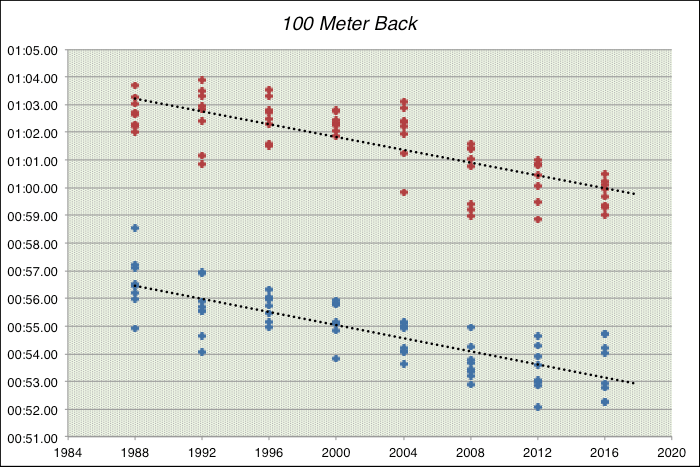
The 100 backstroke showed steady progression, top times rarely lasting longer than the four years between Olympic Trials meets. David Berkoff’s WR in 1988 in a time of 54.91 may have lasted, had a rule change for the backstroke flip-turn not occurred in 1991. In 2008, the women had strong backstroke performances, with closely chased Natalie Coughlin taking gold and a world record in 58.97.
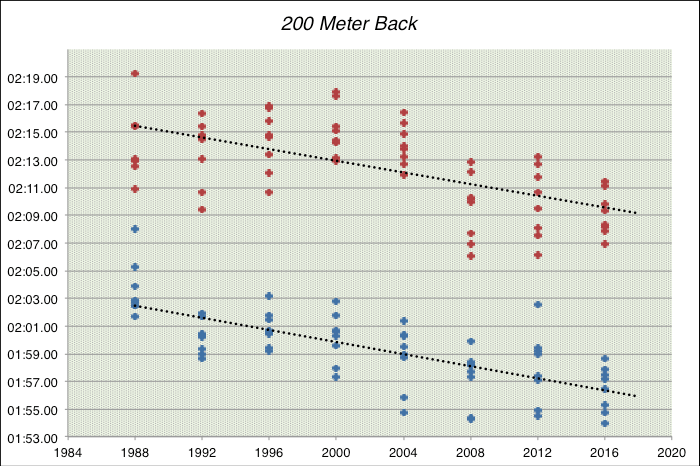
The 200 meter backstroke similar results as the 100, just a bit more variation between competitors. There is a slight slowdown in progress over the last three Olympic Trials compared with the first three recorded here. Aaron Piersol began a history of strong U.S. backstrokers with his 2004 WR of 1:54.74.
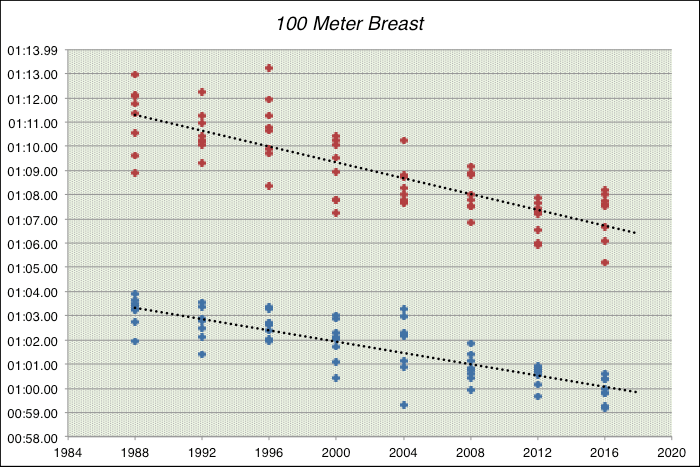
Breaststroke appear to have to most constant progression towards faster times. The most notable deviation from the mean appears to be Brendan Hansen’s WR from 2004, a time of 59.30.
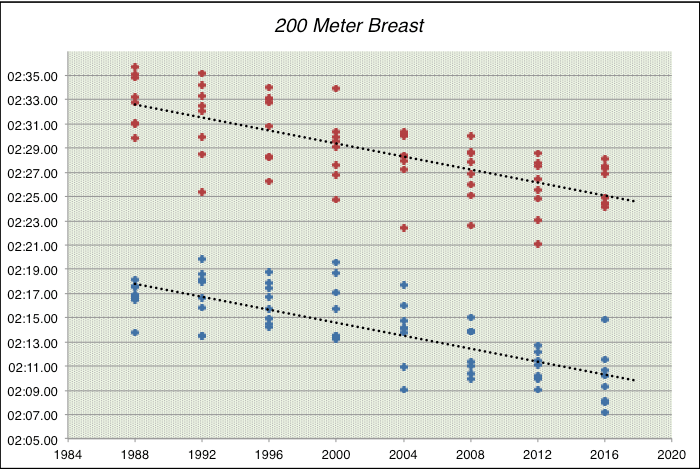
For the women, Amanda Beard stole some attention from Brendan Hansen in the 200 breaststroke in 2004 with her own WR in a time of 2:22.44. Hansen also earned a world record in a time of 2:09.04. Before Beard, Anita Nall put the U.S. in a world scope in 1992 with a WR in 2:25.35.
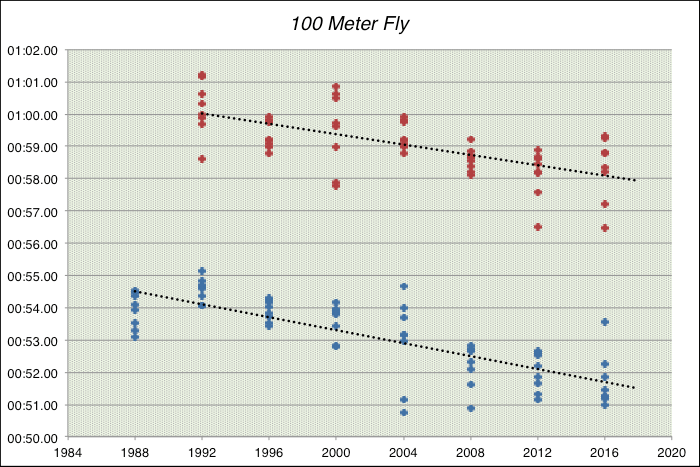
Unfortunately, the online archives of the 100 meter fly for the women were partially distorted so their results do not appear on this scatter plot. In 2004, Ian Crocker set a world record in a time of 50.76, but a young Michael Phelps was not far off the record pace, coming in at 51.15.
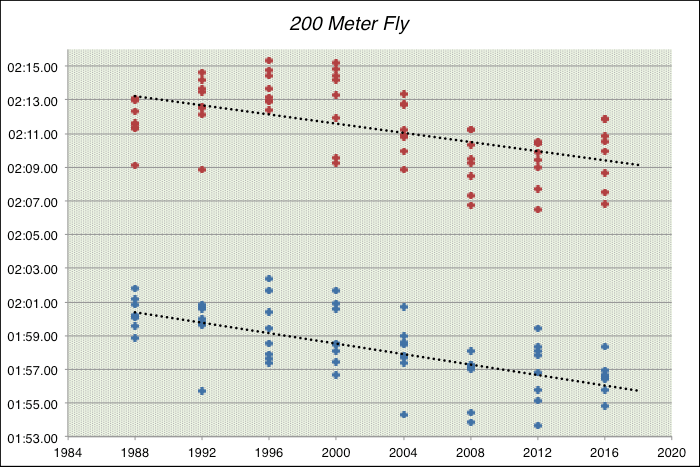
Michael Phelps brought the U.S. into the next level with his strength in the 200 fly, winning in 2004, 2008, 2012, and 2016. He finished with times of 1:54.31, 1:52.20, 1:53.65, and 1:54.84, respectively. Phelps’ finals times were the majority of the few times in U.S. Trials finals history to surpass Melvin Stewart’s 1992 winning time of 1:55.72.
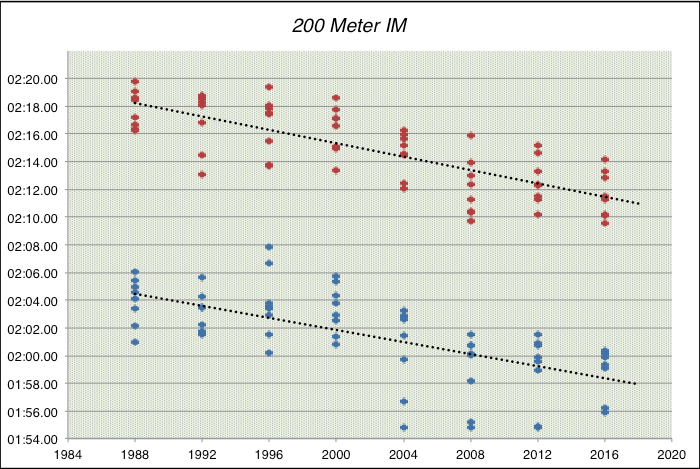
Again in the 200 IM, Phelps showed his dominance in the pool with his 2004 win in 1:56.71. The following Olympic Trials weren’t so easy, as Ryan Lochte crept closer and created a rivalry lasting 12 years of U.S. Olympic Trials. Their closest finish was in London where Phelps finished in 1:54.84 and Lochte finished in 1:54.93.
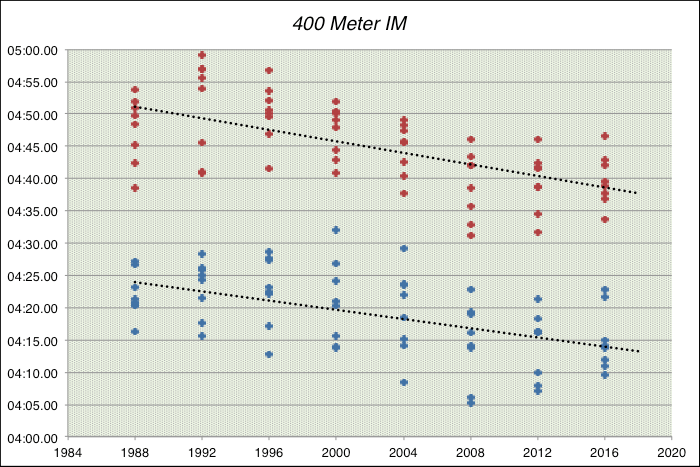
The 400 IM brought another rivalry between Phelps and Lochte, though this time in London Lochte took home gold in a time of 4:07.06. Also entering the 2008 spotlight of high-tech suits and Phelps seeking eight golds in Beijing, was Katie Hoff setting a WR in the 400 IM with a time of 4:31.12.
Full results from previous U.S. Olympic Trials can be found here.




Hannah May Mclean-Leonard